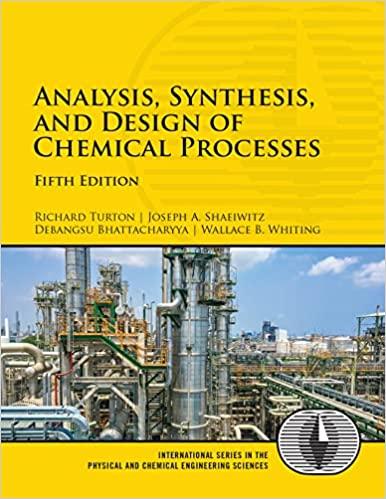Answered step by step
Verified Expert Solution
Question
1 Approved Answer
We desire to produce cumene (C9H12; let's call it C) from propylene (P) and benzene (B): C3H6 +C6H6C9H12 In our preliminary design, a mixture

We desire to produce cumene (C9H12; let's call it C) from propylene (P) and benzene (B): C3H6 +C6H6C9H12 In our preliminary design, a mixture of 95 mol% propylene and 5 mol% propane (an inert gas in this process, so let's call it I) is blended with benzene at a molar ratio of 1.2 moles propylene to 1 mole benzene. This combined "fresh feed" is mixed with two recycled streams, then fed to a reactor. At the reactor conditions, the above reaction occurs, consuming 60% of the available benzene. However, cumene is part of an unwanted side reaction that makes diisopropylbenzene (D): C3H6 + C9H12 C12H18 and 5% of the cumene generated by the first reaction is consumed by this side reaction. The reactor effluent is cooled and sent to a multi-stage separation unit, which ultimately results in four exit streams: a vapor stream containing propylene and propane, and three pure liquid streams, containing benzene, cumene, and diisopropylbenzene. The vapor stream leaving the separator is split; 5% (by moles) is purged from the system, and the rest is recycled to be mixed with the incoming feed stream. The benzene stream leaving the separation unit is recycled, and cumene and diisopropylbenzene are separated and sent to storage tanks. The cumene production rate is 25 mol/s. (a) How much diisopropylbenzene is produced by this design? What is the required fresh feed flow rate to this system? (b) What is the overall conversion of propylene for this design? (c) What is the "single pass" conversion of propylene just for the reactor in this design?
Step by Step Solution
There are 3 Steps involved in it
Step: 1

Get Instant Access to Expert-Tailored Solutions
See step-by-step solutions with expert insights and AI powered tools for academic success
Step: 2

Step: 3

Ace Your Homework with AI
Get the answers you need in no time with our AI-driven, step-by-step assistance
Get Started


